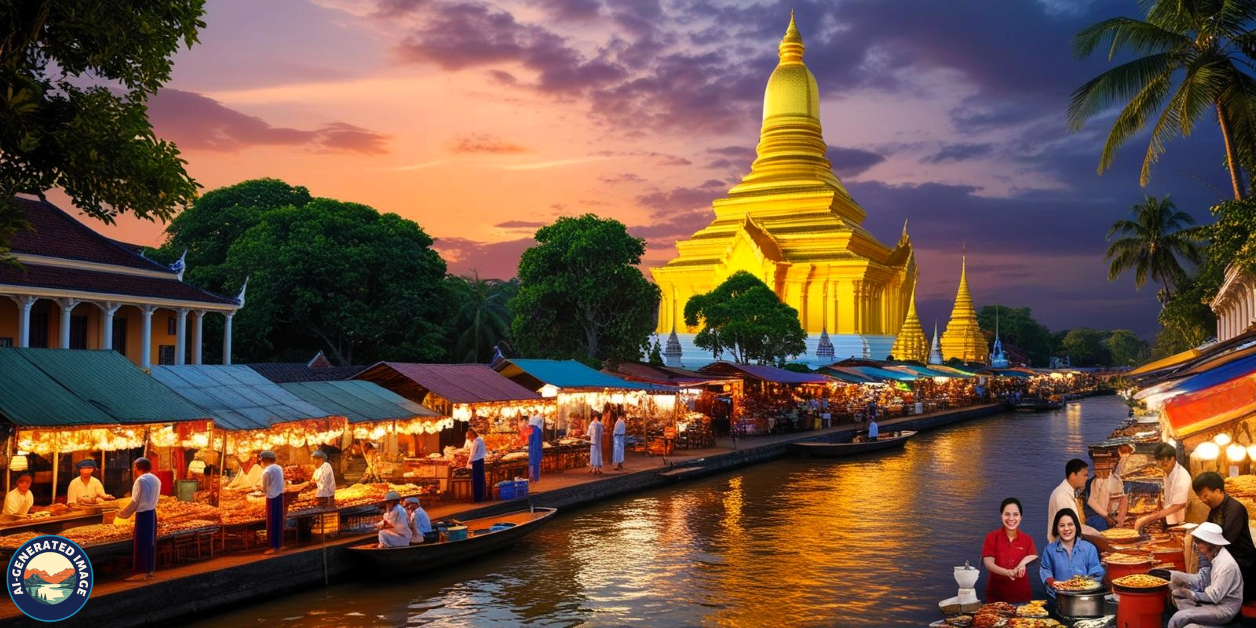Introduction
Vientiane, the capital of Laos, offers a unique contrast to the bustling metropolises of Southeast Asia. Unlike Bangkok or Ho Chi Minh City, Vientiane is known for its tranquil pace, colonial-era architecture, and rich Buddhist heritage. This charming city is a hidden gem, situated along the Mekong River, perfect for travelers seeking culture, history, and relaxation.

Despite its understated reputation, Vientiane is brimming with historical landmarks, delicious cuisine, and a welcoming atmosphere. Whether you’re a history enthusiast, a food lover, or someone seeking a peaceful retreat, this guide will help you discover the best of what Vientiane has to offer.
History and Culture
Vientiane has a storied past that reflects its cultural diversity and historical significance. Originally a small settlement, it rose to prominence as the capital of the Lan Xang Kingdom in the 16th century under King Setthathirath. Many of its most famous landmarks, including the revered Pha That Luang, were established during this period.
Over the centuries, Vientiane experienced various influences, from Siamese rule to French colonialism in the 19th and 20th centuries. The French presence is still visible in the city’s architecture, cuisine, and even language. Despite modern developments, the city has preserved its deep Buddhist traditions, with monks in saffron robes, golden stupas, and temple rituals remaining an integral part of daily life.
Top Attractions
Although Vientiane is compact, it offers numerous attractions that showcase its rich heritage and scenic beauty.
-
Pha That Luang – The Golden Stupa
- Pha That Luang is considered the most important religious monument in Laos. Built in the 16th century, this magnificent golden stupa symbolizes the country’s national identity and Buddhist devotion. It is believed to house a relic of Buddha, making it an essential pilgrimage site. Visiting during the That Luang Festival in November offers a chance to witness vibrant ceremonies and cultural performances.

-
Patuxai – The Victory Monument
- Resembling the Arc de Triomphe in Paris but adorned with Lao motifs, Patuxai is a war memorial dedicated to those who fought for the country’s independence. The monument features intricate designs, and visitors can climb to the top for a breathtaking panoramic view of the city, especially during sunset.

-
Wat Si Saket
- As the oldest surviving temple in Vientiane, Wat Si Saket boasts unique Siamese-style architecture and houses thousands of Buddha images. The temple’s peaceful ambiance and historical significance make it a must-visit for those interested in Lao spirituality and history.

-
Buddha Park (Xieng Khuan)
- Located a short distance from the city center, Buddha Park is an outdoor museum filled with over 200 sculptures of Buddhist and Hindu deities. Created by the monk and artist Luang Pu Bunleua Sulilat in 1958, the park offers a surreal blend of religious symbolism and imaginative artistry.

-
Mekong Riverside Night Market
- For a taste of local culture, the Mekong Riverside Night Market is the perfect place to explore. This lively market offers a variety of souvenirs, handicrafts, and street food. As the sun sets over the Mekong River, the market becomes a social hub where both locals and tourists enjoy delicious food and an inviting atmosphere.
Local Cuisine
Lao cuisine is flavorful and diverse, influenced by neighboring Thailand, Vietnam, and China. Some must-try dishes include:
-
Khao Piak Sen
A comforting rice noodle soup served with fresh herbs and lime.
-
Tam Mak Hoong
A spicy Lao-style papaya salad.
-
Larb
A traditional minced meat salad mixed with fresh herbs and spices.
-
French-inspired baguettes and pastries
- A culinary legacy of French colonial rule, Vientiane is home to excellent bakeries offering croissants and sandwiches.
Many local restaurants and street vendors serve these dishes at affordable prices, making it easy to enjoy authentic Lao flavors.
Best Time to Visit
The ideal time to visit Vientiane is from November to February, when the weather is cool and dry, making sightseeing pleasant. The hot season (March to May) can be quite warm, while the rainy season (June to October) brings lush landscapes and fewer crowds.
How to Get Around Vientiane
Navigating Vientiane is easy due to its compact size. Transportation options include:
-
Tuk-tuks
A fun and inexpensive way to get around, though fare negotiation is recommended.
-
Bicycles and motorbike rentals
Ideal for independent travelers.
-
Taxis and ride-hailing services
Limited but available for longer distances.
Where to Stay
Accommodation options in Vientiane cater to various budgets:
-
Budget-friendly hostels
Suitable for backpackers.
-
Mid-range hotels
These hotels offer comfort and affordability.
-
Luxury resorts
Provide upscale experiences with scenic views.
Hidden Gems and Off-the-Beaten-Path Experiences
For travelers seeking unique experiences, consider:
- Explore local villages along the Mekong River to experience traditional Lao life.
- Visit Ban Anou Night Market for authentic Lao street food.
- Enjoying a Lao herbal spa or massage for relaxation after a day of sightseeing.
Conclusion
Vientiane is a city that blends history, culture, and relaxation in a way that few other capitals do. Whether you’re wandering through ancient temples, savoring flavorful dishes, or simply enjoying the peaceful riverside setting, this city offers a memorable experience. Often overlooked in favor of more well-known destinations, Vientiane is truly a hidden gem waiting to be explored.
FAQs
Is Vientiane worth visiting?
Absolutely! It offers a unique mix of history, culture, and a relaxed atmosphere.
How many days are enough for Vientiane?
Two to three days are ideal for exploring its main attractions.
Is Vientiane safe for tourists?
Yes, it is considered one of the safest cities in Southeast Asia.
Can I use US dollars in Vientiane?
While US dollars and Thai Baht are sometimes accepted, the local currency, Lao Kip, is preferred for everyday transactions.
